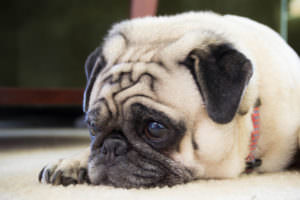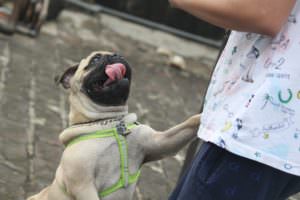Everyone who has lived with or known a pug knows that they are special. Outgoing and friendly, they make people laugh with their comical antics. People love pugs for their cute smashed faces that seem to always smile. Some of my favorite patients are pugs because they always seem happy to see me, frantically wagging their curly tails and spinning around in delight.

Pugs have been crossed with many other breeds and I see these “designer breeds” frequently. One of the most popular crosses I see is the “Puggle”, a pug and beagle cross. Whenever we as humans like a trait, it becomes something that we select for, but sometimes we get some other traits along for the ride that we inadvertently selected for as well. Breed associated disorders are also a part of who pugs are, however, and pugs are so terrific that we take the good with the bad. The ugly part comes in when we are not aware and we do not do things that help offset risks or treat issues that can be treated. Knowledge is power, so I have listed some of the issues that I see in my practice with Pugs and Pug crosses. The same features that make them really cute and adorable are also some of the ones that put them at risk for some of the following disorders.
If you love a pug or are considering one as a family member, you should be aware of these issues.

Brachycephalic Syndrome
A consequence of the short and cute pug face, Brachycephalic comes from the Greek word “brachys” meaning short and cephalic meaning “head”. The syndrome is characterized by features that combine to create more difficulty in breathing and air exchange. The soft palate is often referred to as elongated, but actually the palate is a normal length for a dog that has a normal length snout. It is only elongated when compared to the snubbed nose of these dogs. As you can imagine however, having extra soft tissue in the back of one’s palate can interfere with air exchange. Stenotic nares (narrow nostrils) are another feature that can make breathing more difficult and are a part of brachycephalic syndrome. To make matters worse, the trachea (the airway leading from nose and mouth to the lungs) is hypoplastic (underdeveloped) further impeding easy air exchange. The shortened nose itself is restricted in space for nasal turbinates and the structures that help the nose do its job of filtering air. These characteristics combine to make your pug more likely to snore and more at risk of airway associated issues, like hyperthermia. Some features of brachycephalic syndrome can be improved surgically if your dog’s quality of life is negatively affected.
Demodectic Mange
Demodectic mange is a skin disease that I see more often in young pug dogs than some other breeds. Demodex mites can live on normal healthy skin of any dog in small numbers, but in affected dogs they will will multiply unchecked and cause alopecia and dermatitis. This unchecked growth is thought to be an immune issue and is seen more often in certain breeds, suggesting a genetic link. Your veterinarian can diagnose and manage this issue. Early diagnosis is key. I have treated many of these cases successfully and the affected dogs live a normal life span. Demodectic mange is not specific only to pugs, but does appear more commonly in pugs and many other pure-breeds.

Obesity
I see pugs that suffer from obesity on a routine basis. Because of their thick build, it is easy for them to have excess weight. This weight compounds the airway issues and increases the risk for hyperthermia. Obesity can also increase the chances for osteoarthritis and joint disease because of the increased pressure on the joints. Because there is a propensity for obesity, it is important to monitor your pug’s diet and exercise regimen. All pugs should eat a high quality diet that meets (but does not exceed) their metabolic needs. Even though brachycephalic syndrome can make exercise a challenge and enhance the chances of hyperthermia, all pugs need some exercise to maintain a good body condition and strong cardiovascular system. Your vet can help you devise an exercise plan that is safe for your pug.
Autoimmune Hemolytic Anemia
This predisposition seems to imply a genetic tendency for this disease in which the immune system inappropriately attacks its own blood cells. Anemic pets are unable to exchange oxygen effectively and will be listless and pale. Any pug that is lethargic must see a veterinarian as soon as possible to rule out this disease. It can be medically managed, but is life threatening if left untreated. Because most pugs are naturally cheery and fun, a listless pug is a warning sign.
Pug Dog Encephalitis
Pug dog encephalitis is a syndrome specific to pugs. This necrotizing and inflammatory disorder of the central nervous system causes seizures, abnormal gait, and depression. Medical science has identified the exact chromosome responsible for this fatal issue. Approximately 1 in 100 pugs are affected and the issue seems to be more diagnosed in young female, fawn colored pugs. Because the responsible gene is known, there is genetic testing to identify at risk dogs. (1)
I love pugs and in my life have been owned by a pug cross. They seem to be long lived and healthy when their owners are aware of the issues that are common among them. I have cared for many a pug to a ripe old age in the teens. The key to a long life for your pug lies in knowledge of things that can go wrong and the ways to prevent, identify and manage these issues. The above issues are not only issues for pugs and are certainly not the only things that can go wrong for your pug. A healthy diet and exercise program and a good partnership with your vet can help your pug live a long and valuable life, so he can make you smile for years to come!
1. Talarico LR, Schatzberg SJ. Idiopathic granulomatous and necrotising inflammatory disorders of the canine central nervous system: a review and future perspectives. J Small Anim Pract 2010: 51: 138–149.



